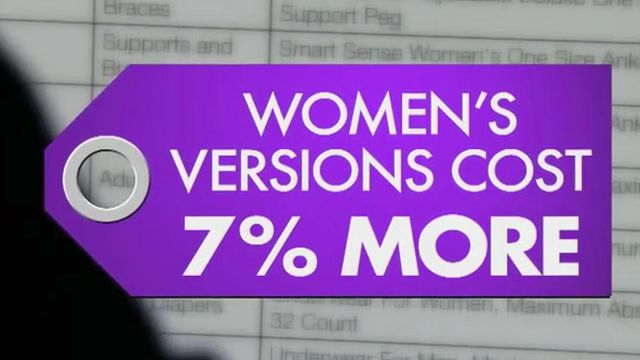It's a fact of life: Women pay more for some products, services
Ever heard of the woman tax? It happens when females pay a higher price just because they're female, and it can be seen in everything from haircuts to razor blades.
Posted — UpdatedEver heard of the woman tax? It happens when females pay a higher price just because they're female, and it can be seen in everything from haircuts to razor blades.
5 On Your Side's Monica Laliberte first looked into the issue 15 years ago, and now it is getting new attention.
In 2001, 5 On Your Side compared six different products that both men and women use and found that women paid about $25 more than men for identical items. The new attention was triggered by a government study in New York. It looked at 800 different products, from toys to clothing to personal care products. Researchers found women paid on average 7 percent more than men for the same product.
It has been called "woman tax," "pink tax" or "gender pricing."
You see it at salons, where a man's haircut costs less, and in clothing, where boot cut jeans cost women $10 more.
5 On Your Side found discrepancies in body wash, shampoo and even socks.
Ryan McDevitt, an assistant professor of Economics at Duke University Fuqua School of Business says manufacturers and stores get away with the "woman tax" because women are willing to pay it.
"I think it really comes down to how much women care about product versus men," he said.
The price differential shows up in services, too.
A hair cut for Kevin's long hair cost $30. A trim for Wendy's short hair, at the same salon, cost $35.
At the dry cleaners, a man's small shirt and a woman's XL – the same amount of fabric – cost different prices to be washed and pressed. According to both cleaners 5 On Your Side visited, women's shirts cost more because they don't fit pressing machines, so they have to be pressed by hand.
The New York study found price differences start with the young. A red scooter, which could be marketed to a girl or a boy, cost $25 less than an identical one in pink.
McDevitt says demand allows for the higher price.
"It's a small segment of the girl population that really wants that pink version that's gonna nag their parents and force their hand and make them pay that premium for the pink version. That's why you see these different prices," he said.
After the study became public, the toy retailer brought the prices back in line.
No federal laws ban so-called gender pricing, but gender price gouging for services, such as hair salons and dry cleaning, is illegal in California, New York and Miami-Dade County in Florida.
Michael Cone, a trade lawyer, says part of the problem is that women's clothing, shoes and gloves often enter the country with a higher import tax than men's. He found it dates back to at least the mid-1800s.
"It may be $5 extra paid to Uncle Sam, but by the time it hits the shelf it can be $10, $12, $13," he said.
McDevitt points out that women have a choice.
"No one's forcing you to buy the woman's version of the product," he said.
And until women send a message to retailers with their wallets, it's unlikely much will change.
"It's all coming down to what consumers are willing to pay for something," McDevitt said. "That's what they're in business to do is to offer us these products that we're willing to pay a premium for."
• Credits
Copyright 2024 by Capitol Broadcasting Company. All rights reserved. This material may not be published, broadcast, rewritten or redistributed.





